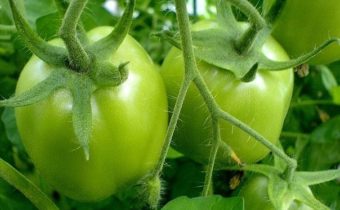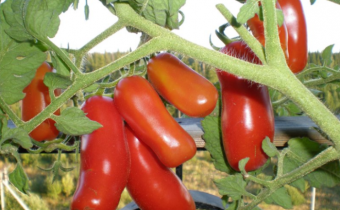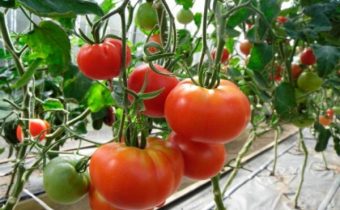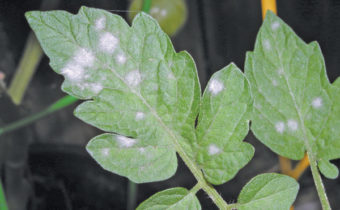Mosaic on the leaves of tomato, what to do?
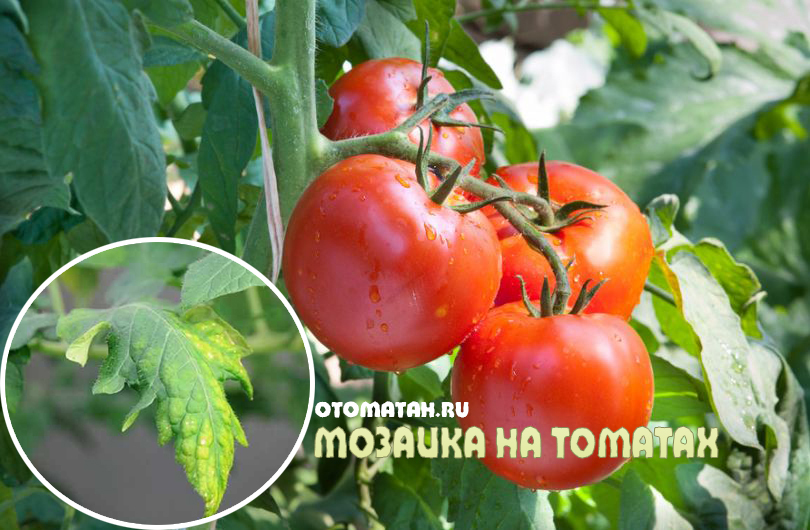
In spring and summer, tomatoes can attack various viruses and diseases. In addition to the well-known phytophtora, mosaic is considered another plague for culture. The disease is considered viral and very quickly leads to the death of tomatoes, especially when inactive. At the first sign of an urgent need to take measures for treatment, to preserve the harvest.
Description and Symptoms
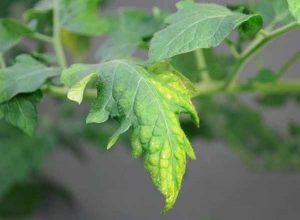 The causative agent of the disease is a virus Tomato mosaic tobamovirus. Infection with the disease occurs mainly through the soil, from neighboring crops (potatoes, cucumbers). Mosaic carriers are often insects: mites, aphids, beetles. The virus can be transmitted to plants from infected planting seeds. After infection on tomatoes, defective fruits of an ugly form and with rotten pulp are formed, and the tomato bushes eventually wither and die. Harvest is reduced by at least 50%.
The causative agent of the disease is a virus Tomato mosaic tobamovirus. Infection with the disease occurs mainly through the soil, from neighboring crops (potatoes, cucumbers). Mosaic carriers are often insects: mites, aphids, beetles. The virus can be transmitted to plants from infected planting seeds. After infection on tomatoes, defective fruits of an ugly form and with rotten pulp are formed, and the tomato bushes eventually wither and die. Harvest is reduced by at least 50%.
The first signs of the disease appear several days after infection. Main symptom - occurrence on the leaves well visible inclusions, which have a bright border. Spots can be of various shapes and sizes. The leaves begin to stretch and curl. Then the stem and the leaves begin to dry out, and the disease with a rapid pace affects the neighboring plants. On the fruit mosaic appears light green, white spots. Tomatoes pulp in infected fruits begins to blacken and rot. These tomatoes are no longer suitable for eating.
The following factors aggravate the course of the disease:
- high ambient temperature;
- high humidity and dampness;
- excess nitrogen fertilizer;
- lack of light.
Mosaic can be of several types: tobacco, ordinary, green and white. Tobacco and ordinary mosaics appear as bright spots, but in the first type of disease the spots develop into bumps. Green and white varieties based on the name form blotches of the corresponding colors. The rest of the disease are similar and are equally dangerous for tomatoes.
Treatment
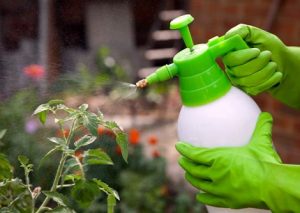 As soon as the virus has hit the plant, it progresses with each passing day, so no need to delay the treatment. The treatment is difficult, because the disease is resistant to low and high temperatures, meaningless to resist the mosaic at difficult stages.
As soon as the virus has hit the plant, it progresses with each passing day, so no need to delay the treatment. The treatment is difficult, because the disease is resistant to low and high temperatures, meaningless to resist the mosaic at difficult stages.
If spots on the leaves are noted, especially on young shoots, they are immediately isolated from other bushes. Infected shoots are cut to a healthy place, the cut must be treated with a solution of potassium permanganate or hydrogen peroxide. Suitable for disinfection pharmaceutical solution of chlorhexidine.
If the disease has just begun to spread throughout the plant, use a special substance, karbofos, for treatment. It has an antimicrobial effect and prevents the formation of pathogenic microflora in healthy plants. 75 grams of powder is required for 10 liters of water. Dilute the drug and applied to the shoots and stem of tomatoes. To fix the result, repeat irrigation after 10 days.
Important!
Already infected mosaic shoots will not be able to recover, they are cut and burned.
At the initial stage of treatment can be made with a mixture of milk and iodine. Dilute 1 liter of milk in 10 liters of water and add 10 drops of iodine. Prepared solution irrigate tomato bushes. Repeat treatment after a week.Iodine has antibacterial properties, and milk contributes to the development of beneficial bacteria that resist the virus.
A disease at an early stage of development can be defeated if fungicides are used - substances containing chemical compounds in their composition that lead to the death of most viruses, including mosaic. Effective fungicides are considered drugs Maxim, Lamador. Dilute supplements must be strictly according to the instructions. Since they contain harmful chemical compounds in the composition, when preparing a solution and treating plants, it is necessary to use protective equipment: gloves and goggles.
Prevention
To avoid having to deal with a dangerous disease, it is necessary to carry out timely prevention of tomatoes. The first step to prevent the occurrence of mosaic is the treatment of tomato seeds before planting. 3-4 crystals of potassium permanganate are diluted in pure water and seeds are soaked for 1-2 hours. Then the seeds are removed from the solution and washed under running water. The planting of the grains is carried out on the same day when the antibacterial treatment was done.
Since the mosaic virus can be in the ground and even winter in it, planting soil is treated in advance. The earth prepared for seedlings is calcined at 80-90 degrees in an oven or in a microwave oven. When the earth has cooled, you can start planting seeds.
Attention!
Mosaic virus dies only at temperatures above 70 degrees.
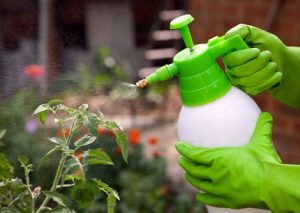 When the seedlings are ready to be planted in open ground, they dig up the earth and shed the soil with a weak solution of boric acid: take a teaspoon of the substance for 10 liters of water. You can add several crystals of potassium permanganate to boric acid, the solution should get a light pink color. When planting seedlings observe the landing distance. It should not be less than 40-50 centimeters from neighboring bushes, and more than 4 plants should not be placed on one square meter of land. Tomatoes are planted away from the potato field and cucumbers.
When the seedlings are ready to be planted in open ground, they dig up the earth and shed the soil with a weak solution of boric acid: take a teaspoon of the substance for 10 liters of water. You can add several crystals of potassium permanganate to boric acid, the solution should get a light pink color. When planting seedlings observe the landing distance. It should not be less than 40-50 centimeters from neighboring bushes, and more than 4 plants should not be placed on one square meter of land. Tomatoes are planted away from the potato field and cucumbers.
If earlier in the garden there were cases of mosaic infection, then the best way to protect tomatoes would be to replace the top layer of the earth. They remove the upper part of the soil with a height of at least 10 centimeters and fill up new fertile soil containing peat and humus in equal parts. The process is rather laborious, but there is no other way to get rid of the virus in the earth.
When the seedlings are planted in a greenhouse or in open ground, after 2 weeks from the start of transplantation, the first prophylaxis is carried out. Spraying can be performed with a 2% solution of copper sulfate or Bordeaux mixture with a mass concentration of 5%. Both supplements strengthen the immune qualities of tomato bushes and reduce the likelihood of infection by mosaic and other infections. The treatment must be repeated after 2 weeks.
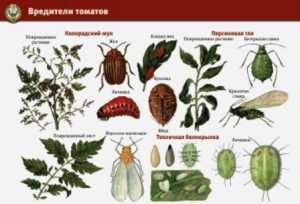 To completely eliminate infection, pay attention to:
To completely eliminate infection, pay attention to:
- Sterility of the instrument. Shovels, rakes should be treated with ethyl alcohol or chlorhexidine.
- Timely weeding from weeds. Being possible carriers, weeds can infect tomatoes with mosaics.
- Spring processing from insects. Insects are carriers of the disease, so tomatoes in mid-May and early June are treated with insecticides.
Some gardeners advise growing certain tomato varieties that are resistant to the virus. These are considered varieties of tomatoes Pasadena, Lord, Zozulya, Semkoross, Othello. However, it must be borne in mind that one hundred percent disease-resistant varieties do not exist. In any case, the infection will occur, even if for some time the plant will resist it. Of course, the listed tomato varieties have certain immune abilities, but they cannot fully resist the infection.
To date, there is no effective drug against the mosaic virus, as it is practically not treatable. If you find the slightest signs of infection, you need to immediately start the fight, otherwise it will be too late.Disease prevention plays a big role in growing tomatoes and minimizes the risk of mosaic infection.


